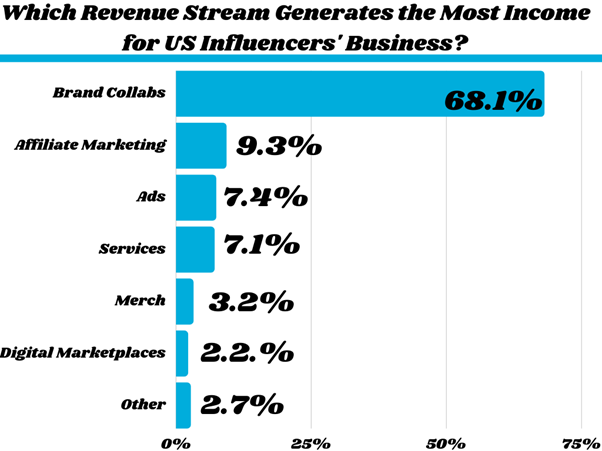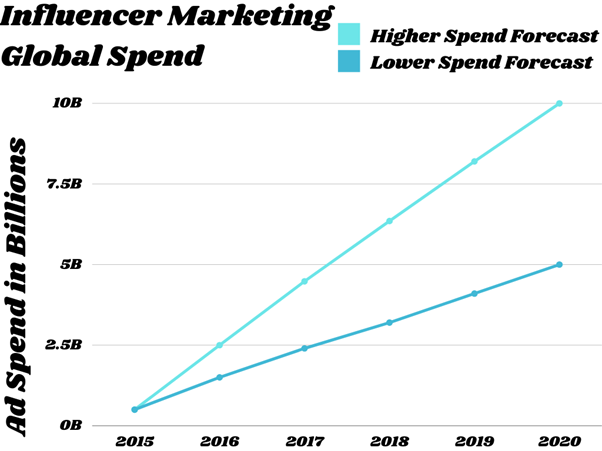It's 2050. The Creator Economy has risen to overtake all world governments. Logan Paul sits in the White House. There's a boxing match to decide who becomes King of the World. Like and Subscribe becomes a genuine trading system. This is Hell.
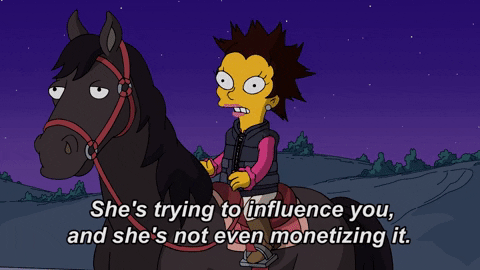
Don't worry, this probably won't happen. Probably. But just in case, it's best to know your enemy. 77% of creators earn their revenue from brand deals, so their livelihoods are in your hands, marketers. Let's see how we can work together.
What is the Creator Economy?
The creator economy refers to the monetisation of work made by independent creators.
From vloggers, to streamers, to influencers, to YouTube dog chefs, the creator economy implies a shift in the dynamics of power in entertainment. This also encompasses the companies supporting these creators, from brand deals to creation tools and analytics platforms. Anyone who makes, or benefits from, independent content creation is affected by the creator economy.
The creator economy is becoming increasingly data- and tech-driven, especially with the shift in entertainment influence, the need to innovate and compete is vital. AI modelling can even be used to discover deeper and more granular insights, in order to grow their platforms. All of this will mean the relationship between brands, creators, and audiences will change. Creators already find themselves reliant on brands, and vice-versa.
The creator economy has three main parts that collaborate to make the industry what it is, according to Mighty Networks:
- Creators which create their own independent businesses around a specific skill, goal, or knowledge set.
- Digital platforms that host the creators, allowing them to grow communities, and business, around their content.
“With the internet and YouTube, there’s always the concern of being demonetized and having your channel cancelled, so people are always looking for alternative ways to earn money,” said YouTuber Joshua Wanders in an interview with New York Times.
“You never know where the platforms are going to take you at the end of the day.”
- Consumers that follow the creators, and buy their content, services, merch, and recommended products.
So, while brands and marketers aren't involved in the immediate creation, they can be seen in every step - from custom content commission, to encouraging consumers to trust the brand through endorsements.
Eric Freytag of Streamlabs, writing for VentureBeat suggests "rather than ten TV shows consumed by billions of people, we now have hundreds of millions of shows that cater to billions of people. You could be only one of ten people in the world interested in a niche topic, but chances are you'll find content for it. Additionally, the people who are creating content for that topic are truly and authentically passionate about it."
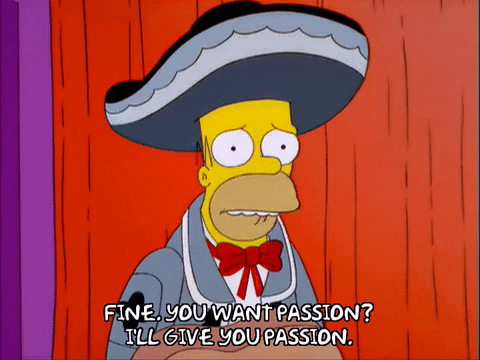
The creator economy has also been described as a subset of the passion economy - creators are basing their work on something that they feel passionate, and knowledgeable about, and are marketing themselves towards people who feel a similar way about the niche. Passionate creators have found a way to make a steady income, be it through the platform they're hosted on, but more likely either subscription sites, or collaborations with brands within their niche.
In an April 2021 survey by influencer marketing platform Mavrck, they actually found that 68.1% of US influencers identified brand collaborations as generating the most income for their business.
Sponsorships and brand collaborations are the most common way creators get that bread. Approximately 77% of creators earn their revenue from brand deals - about three times the amount of revenue from all other sources. This is because it benefits creators and brands in equal amounts - it's a collaborative effort.
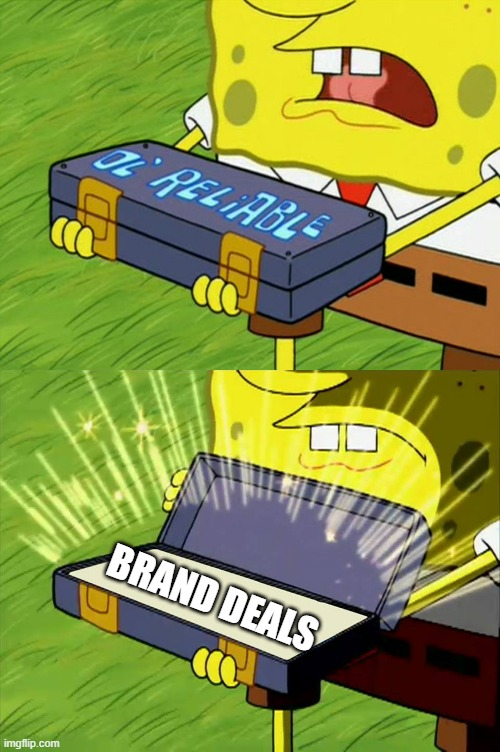
Using platforms as a means of income is an option for creators, albeit an unstable one. This can be done through:
- Advertising revenue shares
- Tipping
- Paid Subscriptions
- Live and virtual events
- Digital content sales
- Shout-outs
Why Does it Work?
Before we get into the 'why', we've got to figure out how we've gotten here. Let's have a look into a brief history of the creator economy, divided into three layers by Yuanling Yuan and Josh Constine:
Layer 1: Foundational Media Platforms. Twitch, Twitter, TikTok, Youtube, Instagram. Platforms help influencers get discovered, through curation algorithms, controlling and solving the distribution problem for creators. Plus, users had easy access to multimedia editing tools to create polished work. But the platforms don't always have creators' best interests in mind, leaving users vulnerable to platform decline, removal of features, and reductions in opportunities.
Layer 2: Monetising Influencer Reach. This is when brands started realising the economic benefits of influencers. Most platforms still left it to the content makers to figure out monetisation, leading to the rise of sponsored content. However, this also meant balancing trust between influencer and audience; with every sponsored post, the trust might shrink, and engagement might lower.
Layer 3: Creators as Businesses. Now, creators are looking to become fully fledged businesses with multiple revenue streams, not just reliant on ads. This might be through providing services, or selling merch, all through providing niche and interesting content.
So, creators are utilising their sphere of influence to become businesses in themselves. Influencers tend to wield a level of loyalty with their fans than traditional businesses, due to the fact that people are more dedicated to people than to faceless brands. Brands are able to capitalise on this by tying themselves to creators, so influencers are therefore able to work within a number of different business models.
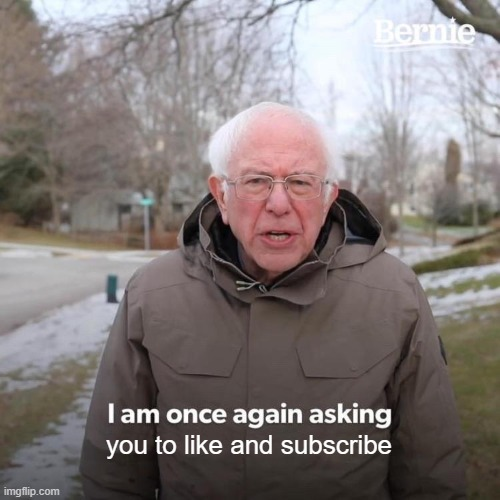
This might mean opportunities for brands in other ways, including getting involved in merchandise sales and collaborations, and streaming deals, as part of an influencer's diversified creator portfolio.
Examples like YouTubers Jeffree Star and Emma Chamberlain, are even building their own offshoot businesses. This might mean the emergence of what Forbes deems "superbrands" - creators who use their deep audience insights and loyalty to inform businesses and business decisions. Some might even launch their own platforms, or services, to continue capitalising on their image.
Influencers even go by different names, in different situations, depending on the type of marketing campaign or compensation structure:
- Affiliates: Industry experts with authority, working on a commission structure. The top-performing YouTube channels reaped $211M between June 2019 and June 2020, Forbes reports.
- Brand ambassadors: what it says on the tin. Brand champions with highly-engaged fans.
- Customer advocates: Brand community members who have a history of brand loyalty, and will take this to the next level for exclusive perks.
- Media producers: or independent contractors. Content creators who will produce work for organic or paid campaigns. The top writers on Substack can rake in as much as $1M annually.
How Do Creators, and Brands, Get Involved?
“There's an arms race to acquire creators,” says Li Jin, founder of Atelier Ventures.
The end goal for a large number of content creators is to become emancipated from platforms and brands, instead focusing on a steady stream of income built by the loyalty of their fans. This can be seen in the three top upcoming trends in the creator economy, suggested by our friends Yuanling and Josh:
- Creators moving their top fans off of social networks and on to their own websites, apps, and tools
- Creators becoming founders, building out teams and assembling tools to help them start businesses, focused around their content
- Creators gaining power in the media ecosystem, leading fans across platforms, as they try to connect with individual personalities, rather than large brands and companies.
“After a decade of building their audiences, a class of Super Creators have emerged that have leverage over their aggregators,” writes Rameez Tase, head of Antenna.
“They simply built such large, engaged audiences that those audiences would follow them anywhere.”
So, while there has always been a sea of content creators to choose from, the most lucrative individuals may find themselves in high demand. On the part of brands, it may be beneficial to look into ways to access influencers in an effective and specific way, including:
Influencer marketing platforms and marketplaces. This can be a much cheaper way to access a large database of influencers, and filter through them. Often charging as a SaaS, plus a take rate on each campaign, these platforms offer analytics and reporting capabilities. Often, the largest influencers only work with agencies, so in this case it might be better to turn to:
Specialised influencer marketing agencies. Brands will hire an agency in order to identify high performing, high earning influencers with niche demographics. This may lead to multiple, cross-channel campaigns, and ROI assessments. This all means direct connections to influencer talent and in-house teams.
CRM tools. CRM tools have been built specifically for influencers, in order to help manage workflow and multiple brand contracts.
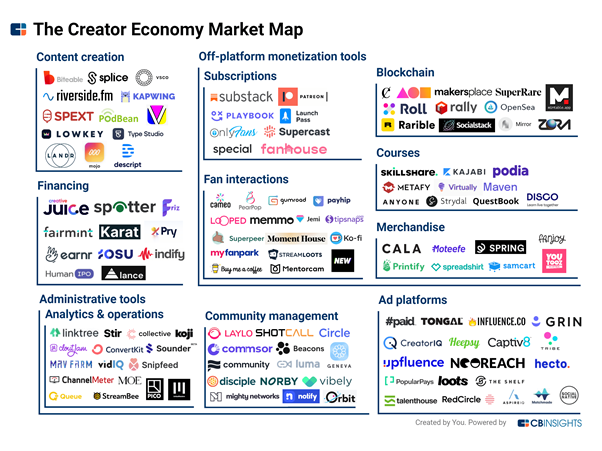
So, what's the future?
The creator economy is a pretty competitive marketplace. Some influencers or content creators may earn considerable amounts of money - nine-year-old Ryan Kaji earned $29.5 million on YouTube in 2020. Kylie Jenner can earn more than $1 million per sponsored Instagram post. But a majority will never come close to this.
46.7 million creators consider themselves to be amateurs. 97.5% of YouTubers, for instance, don't even make enough to reach the U.S. poverty line. This has led to some people, such as Li Jin, seeing this as evidence of the creator economy lacking a middle class.
This means innovation is vital. Sites like Patreon mean creators can earn an income, through small to medium fan bases. Influencer marketing and sponsorship deals can be good for creators on platforms that don't share advertising revenue.

